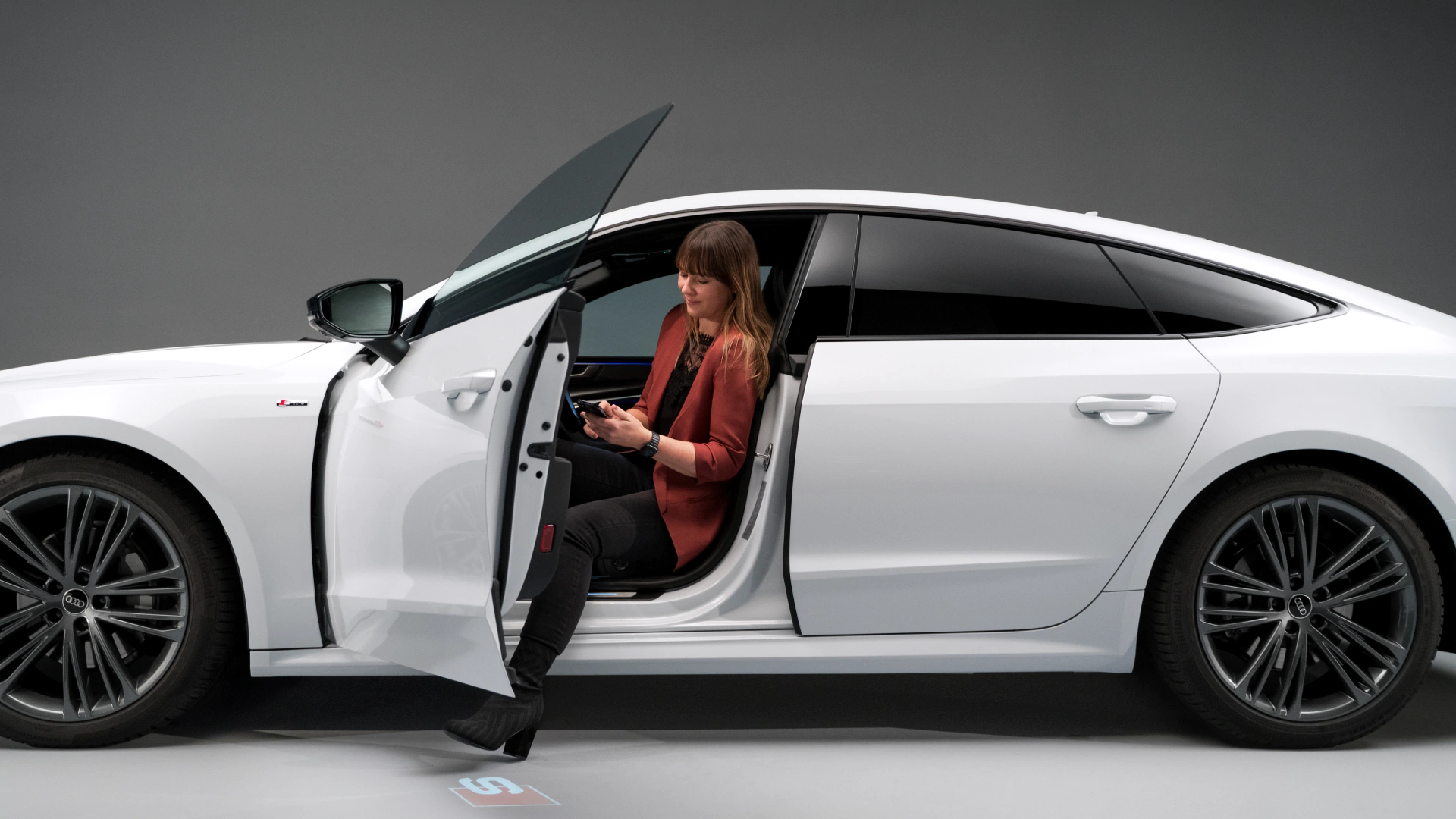Be it for a short excursion or an extended road trip: the Audi Q8 e-tron impresses with its progressive design, long range, higher charging capacity, and exciting technology highlights. The all-electric model also offers a high level of comfort for all passengers and impresses with its driving dynamics. Find your very own Audi Q8 e-tron and experience the holoride technology.
“How did we ever want to drive anything else?”
If you want to make an impact in digital spheres, you need the magic of the physical world, says Nils Wollny, CEO of holoride. In this Audi e-tron story, he explains the role cars could be playing in the future, how he found his way to e-mobility and why teething troubles don’t have to be a problem.

Nils Wollny seeks time out in the countryside as often as he can. He has chosen Munich as his home and likes to go to Lake Tegernsee – in an all-electric Audi Q8 e-tron. His usual companion: his dog Bommel.
Nils Wollny seeks time out in the countryside as often as he can. He has chosen Munich as his home and likes to go to Lake Tegernsee – in an all-electric Audi Q8 e-tron. His usual companion: his dog Bommel.
The view is almost too much to bear. Lake Tegernsee, located south of Munich, is practically deserted on this autumn day, the sun is shining through the clouds and a few waves are rippling on the gravel shore. A dog is jumping through the cold water, you can hear his master whistle for him to come back to the shore. “We come here whenever we can, to recharge our batteries,” says Nils Wollny, one of the founders and CEO of holoride. Although Nils Wollny has spent years working with virtual worlds, augmented realities, and the opportunities of digitisation, he appreciates the “energy and magic that you only get here”. And by “here”, the 42-year-old is referring to Lake Tegernsee in particular, but also to the physical, “real” world in general. But what’s real anyway? “Generations Z and Alpha are already moving more in the digital world than we can imagine. Boundaries are becoming increasingly blurred.”
In 2018, Nils Wollny founded holoride GmbH together with two partners and with the support of Audi. Their vision: an agnostic, open-minded technology start-up that redefines entertainment in connection with mobility. “At the time, I didn’t even have a car! Living in the city centre of Munich, my wife and I simply didn’t need one. When his wife fell pregnant, however, their views changed. “We got interested in e-mobility and started a car subscription,” Nils Wollny recalls. “We were just curious and wanted to find out whether e-mobility suited us.” That’s the way it works with new technologies. You first have to integrate them into your own everyday life before you can form an opinion. It’s actually the same with holoride. “We soon realised how electric driving had changed us in a positive way. The driving experience, the typical sound: We were more relaxed on the road, and we were more relaxed in general, too, outside the car.” Nils Wollny cannot imagine ever going back, on the contrary: “You start to wonder: how did we ever want to drive anything else?”

Nils Wollny has a long history with Audi. He wrote his diploma thesis in Ingolstadt and was later Head of the Digital Business department.

In 2018, Nils Wollny founded holoride GmbH together with Marcus Kuehne, Daniel Profendiner and Audi. Their vision: an agnostic, open-minded technology start-up.
Nils Wollny has a long history with Audi. He wrote his diploma thesis in Ingolstadt and was later Head of the Digital Business department.
In 2018, Nils Wollny founded holoride GmbH together with Marcus Kuehne, Daniel Profendiner and Audi. Their vision: an agnostic, open-minded technology start-up.
“People often overestimate new technologies at first, and then they underestimate their long-term impact.”
Nils Wollny
Of course, not everything is perfect, and Wollny knows there are a few challenges to overcome. “In the beginning, there were four charging points in our neighbourhood and practically no e-vehicles. That was a big plus for us, obviously. Today, there are significantly more cars and only disproportionately more charging points.” And it’s nagging him that you still need different payment methods at different charging points. But as a founder he knows that technology needs time to mature. “Iteration is unavoidable in this area. People often overestimate new technologies at first, and then they underestimate their long-term impact.”
Nils Wollny likes to look to the future. For him, automobiles over a lot of potential beyond drive technology. “Over the past few decades, we have evolved from stationary to mobile computing. Smartphones have become some kind of an icon.” In his opinion, the next big step is towards spatial computing. Which means: moving away from static screens and connecting digital objects with physical locations or interacting with digital content in physical space. Cars with their highly developed sensors are the perfect means for this, the ideal spatial device. Keywords are virtual, augmented and mixed reality, although they differ in terms of the degree of immersion. In his opinion, Audi has already given a small preview of this kind of future with the Audi activesphere concept.

Despite digitisation, Nils Wollny appreciates the energy and magic that can only come from the physical world, which is still commonly referred to as the “real” word.
Despite digitisation, Nils Wollny appreciates the energy and magic that can only come from the physical world, which is still commonly referred to as the “real” word.
“You first have to integrate new technologies into your own everyday life before you can form an opinion.”
Nils Wollny
At some point, the autumn weather sets in at Lake Tegernsee, and while he is securing Bommel in the back seat of the Audi Q8 e-tron, Nils Wollny has another thought. You must be careful not to overwhelm people. With holoride, the offer has now been adapted to make it easier for those interested in getting used to it. In addition to games that can be played in the back seat using a VR headset and whose content interacts with the movements of the vehicle, they now also offer video-on-demand. “Passengers who use the service can no longer just watch films on a small tablet, but they use a headset that also captures their peripheral vision. It’s an entertainment offer, but it also helps to avoid motion sickness,” Nils Wollny explains.
Despite all the excitement about the technical possibilities, it is important not to lose sight of “the people and the problems they perceive when using these technologies”. Because then, at some point, people will wonder how they ever managed without it. Exactly like the time Nils Wollny discovered e-mobility for himself.

Users can only use holoride inside the vehicle where family dog Bommel is sitting: in the side seat positions of the second row.

This headset enables you to dive into the immersive world of holoride. For Nils Wollny, it is the gateway to the in-car entertainment of the future.
Users can only use holoride inside the vehicle where family dog Bommel is sitting: in the side seat positions of the second row.
This headset enables you to dive into the immersive world of holoride. For Nils Wollny, it is the gateway to the in-car entertainment of the future.
“I was just really curious”
Some challenges of electromobility are obvious to Nils Wollny. So is an approach to solving them. Manufacturers of electric vehicles and providers of charging infrastructure must work together even more closely and openly. At the same time, many prejudices against electric driving have long been dispelled. Three questions for Nils Wollny about electromobility.
01. How did you end up with e-mobility?
I was just really curious about it and simply had to try it. The driving experience convinced me right from the start. The driving dynamics and acceleration felt wonderful.
02. What was surprising?
Your driving style changes very quickly. I am much more relaxed and slower on the road than before. Interestingly enough, since I’ve been driving electrically, combustion engines seem ancient somehow. After our first subscription contract expired, we were offered a hybrid model, but even that seemed wrong to us. We then decided in favour of a fully electric Audi. To this day, that feeling hasn’t gone away, if anything it has only intensified.
03. What annoys you most in everyday electric mobility?
We can and must continue to work on the charging infrastructure. And I don’t just mean the availability of charging points. It’s not a pleasant situation to be standing in unlit corners at motorway service areas on long journeys to charge, often without any protection from the rain. It happens all too often that I head for a charging point, and when I arrive it’s missing or inactive. However: I’ve never been stranded either.

In Nils Wollny’s eyes, the charging infrastructure has improved in many places. There are now also many options around Lake Tegernsee. And yet he finds there is still room for improvement.

It is the quiet, smooth, and relaxed driving that users of e-mobility appreciate. Nils Wollny now leads a more relaxed lifestyle in general, too, outside the car.
In Nils Wollny’s eyes, the charging infrastructure has improved in many places. There are now also many options around Lake Tegernsee. And yet he finds there is still room for improvement.
It is the quiet, smooth, and relaxed driving that users of e-mobility appreciate. Nils Wollny now leads a more relaxed lifestyle in general, too, outside the car.




